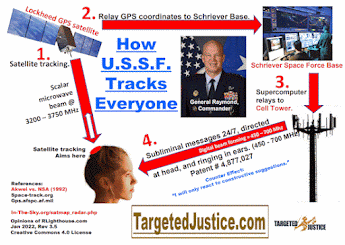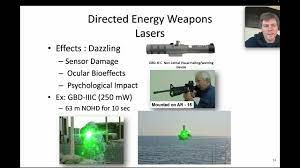Patent No. 4959559 Elecromagnetic or other directed energy pulse launcher
Patent No. 4959559 Elecromagnetic or other directed energy pulse launcher (Ziolkowski, Sep 25, 1990)
Abstract
The physical realization of new solutions of wave propagation equations, such as Maxwell's equations and the scaler wave equation, produces localized pulses of wave energy such as electromagnetic or acoustic energy which propagate over long distances without divergence. The pulses are produced by driving each element of an array of radiating sources with a particular drive function so that the resultant localized packet of energy closely approximates the exact solutions and behaves the same.
Notes:
The U.S. Government has rights to this
invention pursuant to Contract No. W-7405-ENG-48 between the U.S. Department
of Energy and the University of California, for the operation of Lawrence Livermore
National Laboratory.
BACKGROUND
OF THE INVENTION
The invention relates generally to transmission of pulses of energy, and more
particularly to the propagation of localized pulses of electromagnetic or acoustic
energy over long distances without divergence.
As the Klingon battle cruiser attacks the Starship Enterprise, Captain Kirk
commands "Fire photon torpedoes". Two darts or blobs of light speed toward their
target to destory the enemy spaceship. Stardate 1989, Star Trek reruns, or 3189,
somewhere in intergalactic space. Fantasy or reality. The ability to launch
localized packets of light or other energy which do not diverge as they travel
great distances through space may incredibly be at hand.
Following the pioneering work of J. N. Brittingham, various groups have been
actively pursuing the possibility that solutions to the wave equation can be
found that allow the transmission of localized, slowly decaying pulses of energy,
variously described as electromagnetic missiles or bullets, Bessel beams, transient
beam fields, and splash pulses. These efforts have in common the space-time
nature of the solutions being investigated and their potential launching mechanisms,
pulse-driven antennas.
Brittingham's original work involved a search, over a period of about 15 years,
for packet-like solutions of Maxwell's equations (the equations that describe
how electromagnetic waves propagate). The solutions sought were to be continuous
and nonsingular (well-behaved, realizable), three-dimensional in pulse structure
(localized), and nondispersive for all time (faithfully maintaining their shape).
They were also to move at the velocity of light in straight lines and carry
finite electromagnetic energy. The solutions discovered, termed focus wave modes
(FWMs), had all the aforementioned properties except the last; like plane-wave
solutions to the same equations, they were found to have finite energy density
but infinite energy, despite all attempts to remove this deficiency, and thus
are not physically realizable.
Conventional methods for propagation of energy pulses are based on simple solutions
to Maxwell's equations and the wave equation. Spherical or planar waveforms
are utilized. Beams of energy will spread as they propagate as a result of diffraction
effects. For a source of diameter D and wavelength of .lambda. the distance
to which a pulse will propagate without substantial spread is the Rayleigh length
D.sup.2 /.lambda..
Present arrays are based on phasing a plurality of elements, all at the same
frequency, to tailor the beam using interference effects. In a conventional
antenna system, such as a phased array driven with a monochromatic signal, only
spatial phasing is possible. The resulting diffraction-limited signal pulse
begins to spread and decay when it reaches the Rayleigh length L.sub.R. For
an axisymmetric geometry, an array of radius a, and a driving wavelength of
.lambda., L.sub.R is about a.sup.2 /.lambda..
There have been several previous attempts to achieve localized transmission
beyond this Rayleigh distance with conventional systems. The best known of these
are the super-gain or super-directive antennas, where the goal was to produce
a field whose amplitude decays as one over the distance from the antenna, but
whose angular spread can be as narrow as desired. There are theoretical solutions
to this problem, but they turn out to be impractical; the smallest deviation
from the exact solution completely ruins the desired characteristics.
The original FWMs can be related to exact solutions of the three-dimensional
scalar wave equation in a homogeneous, isotropic medium (one that has the same
properties at any distance in all directions). This equation has solutions that
describe, for example, the familiar spherical acoustic waves emanating from
a sound source in air.
The FWMs are related to solutions that represent Gaussian beams propagating
with only local deformation, i.e., a Gaussian-shaped packet that propagates
with changes only within the packet. Such a pulse, moving along the z axis,
with transverse distance denoted by .rho., ##EQU1## is an exact solution of
the scalar wave equation developed by applicant. This fundamental pulse is a
Gaussian beam that translates through space-time with only local variations.
These pulses can also form components of solutions to Maxwell's equations.
These fundamental Gaussian pulses have a number of interesting characteristics.
They appear as either a transverse plane wave or a particle, depending on whether
k is small or large. Moreover, for all k they share with plane waves the property
of having finite energy density but infinite total energy.
Thus traditional solutions to the wave equation and Maxwell's equations do not
provide a means for launching pulses from broadband sources which can travel
desirable distances without divergence problems. The laser is a narrowband light
source which has a relatively low divergence over certain distances (i.e. relatively
long Rayleigh length). However, acoustic and microwave sources, because of longer
wavelengths, are more severely limited. Phased arrays do not provide the solution.
Accordingly, it is an object of the invention to provide method and apparatus
for launching electromagnetic and acoustic pulses which can travel distances
much larger than the Rayleigh length without divergence.
It is also an object of the invention to provide method and apparatus for launching
pulses which approximate new solutions to the scalar wave and Maxwell's equations.
It is another object of the invention to physically realize new solutions to
the scalar wave and Maxwell's equations which provide localized packets of energy
which transverse large distances without divergence.
It is a further object of the invention to provide compact arrays for launching
these pulses.
SUMMARY
OF THE INVENTION
The invention is method and apparatus for launching electromagnetic and acoustic
energy pulses which propagate long distances without substantial divergence.
A preferred embodiment of the invention is based on the recognition that a superposition
of the FWM pulses can produce finite-energy solutions to the wave equation and
to Maxwell's equations. As with plane waves, the infinite-energy property is
not an insurmountable drawback per se. The variable k in the solution provides
an added degree of freedom, and these fundamental Gaussian pulse fields can
be used as basis functions, a superposition of which represent new transient
solutions of the wave equation. In other words, these infinite-energy solutions
can be added together, with the proper weighting, to yield physically realizable,
finite-energy solutions. More generally, the invention applies to any nonseparable
space-time solution .PHI..sub.k (r,t) of the relevant wave propagation equation,
and may in some cases even be based on an approximate solution.
For example, either the real or imaginary part of the function ##EQU2## (where
.PHI..sub.k is the exact solution or an approximation thereof) is also an exact,
source-free solution of the wave equation. The F(k) function is the weighting
function (the spectrum), and the resulting pulses having finite energy if F(k)
satisfies certain integrability conditions. This representation utilizes basis
functions that are localized in space and, by their very nature, are a natural
basis for synthesizing pulse solutions that can be tailored to give directed
wave energy transfer in space. A bidirectional representation is also possible,
which leads to analogous solutions in geometries that have boundaries (propagation
of waves in waveguides).
Solutions to Maxwell's equations follow naturally from these scalar wave equation
solutions. Such electromagnetic pulses, characterized by their high directionality
and slow energy decay, are called electromagnetic directed-energy pulse trains
(EDEPTs). They are a step closer to a classical description of a photon, a finite-energy
solution of Maxwell's equations that exhibits a wave/particle duality. The corresponding
acoustic pulses, which are solutions of the scalar wave equation, are called
ADEPTs.
In most general terms, the invention starts with a solution .PHI..sub.k (r,t)
of the relevant wave equation (scaler wave equation, Maxwell's equations or
other equations), chooses an appropriate weighing or spectrum function F(k),
computes a drive function f(r,t) and applies the appropriate drive function
to each element of an array to launch pulses of wave energy.
The invention particularly applies to broadband sources such as acoustic and
microwave sources. Each element of an array of radiating elements is driven
by the appropriate driving function for that individual element. The array is
preferably a finite planar array, and may be folded to produce a more compact
configuration.





Comments